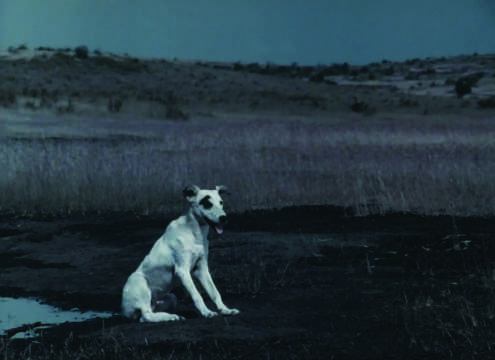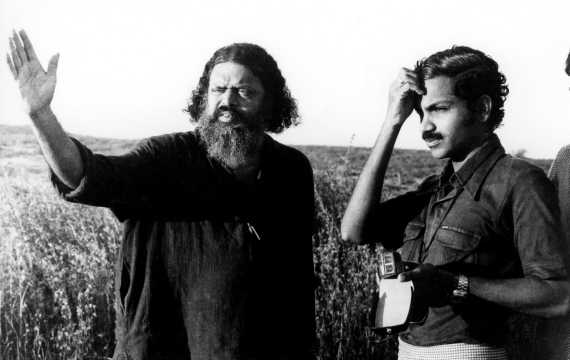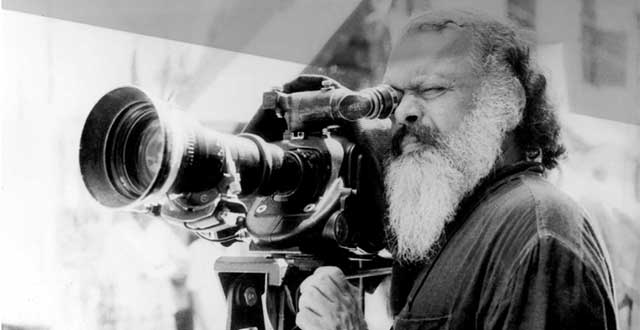News
L'amore per il cinema al centro del Festival Lumière
Fabien Lemercier
"As for me, addressing you here, I admire everything, like a savage." This quote from Victor Hugo, favoured by the much missed Bertrand Tavernier (who was President of the Institut Lumière from its creation in 1982) to whom the 13th edition of the Lumière Festival (steered by Thierry Frémaux) is clearly set to pay tribute, perfectly illustrates the passion that is invested into the biggest global event dedicated to heritage cinema. It’s an immoderate love for the 7th art which has transformed the festival into an incredibly popular gathering, which will once again raise its curtain from 9 to 17 October with a colossal line-up of over 420 films.
The 2021 Lumière Award is set to be handed to Jane Campion, who will form the focus of a retrospective, as well as delivering a masterclass on 15 October. Also worth a mention, within the context of the "Permanent History of Women Filmmakers” section, is a retrospective dedicated to Kinuyo Tanaka, who was a woman director in the golden age of Japanese film.
Stealing focus among the various guests the festival plans to honour (with several premières gracing the agenda) are Paolo Sorrentino (who will deliver a masterclass on 10 October and whose film The Hand of God [+] is set for a screening), Marco Bellocchio (notably with his documentary Marx Can Wait [+]), Maggie Gyllenhaal (The Lost Daughter [+]), Bulle Ogier (also delivering a masterclass), Catherine Corsini (The Divide [+]), Joachim Trier, presenting The Worst Person in the World [+], Juan Antonio Bayona, Édouard Baer (with Adieu Paris, among other works), composer Philippe Sarde (who’s also planning a masterclass), Gessica Généus (Freda [+]), Yvan Attal (The Accusation [+]), Christian Carion (My Son [+]) and the trio Gaspar Noé - Dario Argento - Françoise Lebrun with Vortex [+]. Tributes to the sorely missed Sydney Pollack and Gilles Grangier also deserve a mention.
Standing out in the Celebrations category are "1971, The Birth of Blaxploitation", "Clint Eastwood: 50 Years of A Filmmaking Career", the 30-year anniversary of Maurice Pialat’s Van Gogh and a tribute to Fernando Solanas. The Re-Release Events line-up, meanwhile, will shine a light on the adventures of Antoine Doinel by way of François Truffaut’s films, as well as showcasing the Infernal Affairs trilogy and three Japanese cult horror films.
The "Big Classics in Black and White" line-up will include works coming courtesy of Buñuel, Duvivier, Carné, Kurosawa, Welles, Wilder, Lubitsch, Franju and Fellini, to name a few, while the "Sublime Moments of Silent Film" selection will notably present works by Eisenstein, along with Louis Feuillade’s Judex series. Likewise on the agenda, we find "Epic Screenings" (Pollack, De Palma, Swain, Barboni, Chahine, etc.), documentaries about film, a Jurassic All-Nighter, a string of titles supported by the Lumière Classics label (directed by McCarey, Powell and Pressburger, Renoir, Scola, Dmytryk, Corbucci, Tanner, Decoin, Clément, Castellani, Berlanga and Bardem, Fernández, etc.) and "Treasures and Curiosities" (Nemec, Jancsó, Makavejev).
And one to mention in closing, running from 12 to 15 October, is the 9th edition of the International Classic Film Market which will honour Switzerland, will feature America’s Margaret Bodde (who oversees The Film Foundation founded by Martin Scorsese) as its Expert Guest, and will decipher the current state of the sector during thematic round table talks, in addition to the usual film screenings and presentations of various line-ups.
NOTES ON FILM & RESTORATION
Michael Powell’s glorious version of Béla Bartók’s 1911 one-act opera began life with its star, the American operatic bass singer Norman Foster (not to be confused with the actor and director). Foster wanted to pair the opera with Bartók’s equally compact ballet of 1916, The Miraculous Mandarin, and film them at a new studio in Salzburg, for German television. Foster came to Powell via production designer Hein Heckroth, one of the director’s most cherished collaborators. Foster would sing and play the role of Bluebeard and the Uruguayan mezzosoprano Ana Racquel Satre would be Bluebeard’s fourth wife Judith. Powell bought a recording with Dietrich Fischer-Dieskau as Bluebeard and he was sold (the ballet, on the other hand, left him non-plussed and that idea was dropped). He ordered a copy of the score and got to work on a script, and commenced to criss-crossing Europe in his red land rover for finance and production meetings, alighting in Vienna, then Heckroth’s home base of Frankfurt, then Munich, then Salzburg, then Zagreb to meet with the conductor Milan Horvath. Shooting started while the studio was still being built, Powell and Heckroth conjured wonders out of color and lights and polystyrene forms and camera placement and movement, and the production wrapped in eight and a half days. “What did it matter that there was not enough money to pay everybody the fees that had been agreed?” wrote Powell in the second volume of his autobiography. “There is always something a little unreal about being paid for doing something that you love to do. All of us were artists, and all of us had a little of this feeling—fortunately for Norman. We ate well, we drank well, and we slept well, and we loved one another. We knew what we were doing, and we saw that it was good. We had made new friends, and no enemies. It was one of the most delightful experiences of my life in movies.” After it was broadcast on German television (in black and white!), Bluebeard’s Castle languished in obscurity for many years. It has just been restored by the BFI and The Film Foundation, and will be screened at this year’s New York Film Festival.
I realize that since I started writing these posts, I’ve given a lot of attention to titles by Michael Powell, the majority of them made with Emeric Pressburger. For many reasons. On a personal note, I came to Powell’s films through Martin Scorsese, the founder of The Film Foundation, and Thelma Schoonmaker, who was married to Powell in the last years of his life and who has devoted so much time and loving care to the meticulous restoration and preservation of his films and his writings. Margaret Bodde and I discovered a lot of these movies in a screening room with Marty and Thelma, and over the years I’ve come back to them again and again. And with every new viewing, they seem to become more wondrous—that’s the way it is with all great films. There have been many great filmmakers, but only a very few like Michael Powell, the spirit of whose work is all but inseparable from the spirit of the art form itself.
- Kent Jones
Follow us on Instagram, and Twitter!
HERZOG BLAUBARTS BURG (BLUEBEARD'S CASTLE) (1963, d. Michael Powell)
Restored by the BFI National Archive and The Film Foundation in association with The Ashbrittle Film Foundation. Restoration funding provided by the BFI National Archive, The Louis B. Mayer Foundation and The Film Foundation.
‘Possession’ and the Lost Movies of the Streaming Wars
Laura Babiak
A look into the movies that have become inaccessible in this time of unprecedented accessibility.
In 2017, film archivists at Martin Scorsese’s The Film Foundation estimated that half of all American films made before 1950 are now lost, unable to be viewed, and perhaps more than 90% of films made before 1929 are similarly gone forever. At the Library of Congress, experts have found that 70% of silent films have been completely lost, with many of the remaining silent films being incomplete or lower-quality versions.
While this seems like it would be limited to the olden, Golden Age days of film—a result of chain-smoking studio executives waving away rolls upon rolls of film in trans-Atlantic accents, banishing them to damp, dark basements to never see the silver screen again—the loss of movies from recent history is becoming more and more common as the streaming wars rage on.
Take, for instance, the 1981 film Possession, an international production with all of the ingredients to be an enduring cult classic. Directed by Andrzej Żuławski, this mind-boggling divorce horror movie (a genre we can only hope to see more of in the future) stars Isabelle Adjani in a role that won her the Best Actress award at the Cannes Film Festival. She plays a far more unhinged prototype of Gone Girl’s Amy Dunne; opposite of her is rising star Sam Neill as a Berlin spy and absent husband. The film chronicles the tense and terrifying erosion of their marriage, blending elements of realism with the alien and supernatural. The whole thing takes place in West Berlin, with the Berlin Wall in view for a hefty amount of screentime to add an extra degree of Cold War tension and mystery. Possession is an irresistibly weird movie, a status which resulted in the film being cut by over 40 minutes in its original American release.
With such a fascinating story behind it, Possession is a hidden gem of a film—emphasis on the hidden. The movie has been missing from streaming services for years; you can’t even rent or buy it on Amazon Prime or YouTube or iTunes. For all intents and purposes in the streaming era, Possession just doesn’t exist. Unless, of course, you scour the secondhand markets of Amazon and eBay, where I was ecstatic to purchase a Korean version of the DVD for a mere $5 (European and American prints of the disc range anywhere from $30 to upwards of $80).
This kind of movie scarcity may seem like a fluke, with Possession being a single example of something valuable falling through the cracks, but it’s hardly the only film to suffer the fate of extinction. Another work from the not-too-distant-past that seems incapable of reaching our screens is 1999’s beauty pageant mockumentary Drop Dead Gorgeous. The film contains a bevy of talent, from Allison Janney to Kirsten Dunst, Kirstie Alley to the late Brittany Murphy. It’s perennial Oscar-nominee Amy Adams’ first role ever. That alone (and Denise Richards’ awe-inspiring talent portion performance, of course) should cement it as a staple for streaming!
Somehow, though, Drop Dead Gorgeous wasn’t available on streaming platforms until two decades after its release. Once it arrived, many a think piece came out praising the film’s absurd but truthful depictions of teenage girlhood, bolstering its status as a cult classic. After searching in vain for the movie for years, I was lucky enough to catch it on Hulu during the short window it was there. But it has inexplicably disappeared again. Now, it’s still unavailable for streaming or purchase digitally—once again, secondhand DVDs are your only option to see it.
Physical media, though going out of style, is the only way to access many great movies that streaming has excluded over the years. The Diana Ross 1972 vehicle Lady Sings the Blues received a Blu-Ray rerelease this year, after only scarce, decades-old copies could be found online and in stores. Surely Ross’ name and ongoing legacy deserve better preservation than that. 1977’s New York, New York stands as another unlikely lost movie, if not for it’s A-list director and stars (Martin Scorsese, Liza Minnelli, and Robert De Niro), then for its extraordinarily famous theme: the song “New York, New York,” most notably covered by Frank Sinatra, came from this film! In spite of that enduring cultural touchstone of a song, the movie has all but ceased to exist.
The list goes on and on, made up of everything from Oscar winners (1978’s Coming Home starring Jane Fonda, Jon Voight, and Bruce Dern) to controversial independent ventures (Spring Breakers, director Harmony Korine’s first writing credit, and the NC-17-rated Kids). The fact is, there is no way to know what these streamers are missing unless you know these lost films for yourself. Many require you to hunt them down, to buy secondhand, to potentially pay exorbitant amounts for first edition copies because those are the only ones in existence. Though streaming seems to offer an endless number of titles at the click of the button, there’s a limit to what these platforms house, and many hidden gems are too often forced out of the cinematic consciousness as a result.
With all of that being said, Possession has lucked out. Via some kind of divine intervention (because what else could motivate the resuscitation of a 40-year-old movie?), Metrograph has created a 4K restoration of the film to be released both in theaters and digitally. Possession is set to premiere at Austin’s Fantastic Fest in the last week of September, after which it will be available in person and online through Metrograph in New York on October 1 before opening nationwide October 15. Hopefully, this rerelease will prompt revivals of other lost movies, so we can finally watch what we didn’t know we’d been missing.
G Aravindan's Kummatty: A breathtaking ode to childhood innocence and nature's splendour
Shoma A Chatterji
The Malayalam classic was recently restored by the Film Foundation’s World Cinema Project, Film Heritage Foundation and Cineteca di Bologna.
One of the tragedies of media history is that many have forgotten G Aravindan, who maintained a very low profile, and his rich contribution to Indian cinema since his passing away at a relatively early age in 1991.
Govindan Aravindan was one of India’s greatest filmmakers and a leading light during the golden age of Malayalam cinema in the 1970s and 1980s. He was a man of many talents — painter, cartoonist, musician, theatre director and filmmaker.
The autodidact's films were marked by an entirely original approach to cinema. He has been described as a poet-philosopher with a vision, and he made mystical, transcendental films that showed deep compassion for the eccentric, the marginalized and the alienated. In a career spanning 1974 to 1991, he made 11 films and 10 documentaries with almost all of his works receiving national or state awards.

The Film Foundation’s World Cinema Project — a programme created by Martin Scorsese in 2007, Film Heritage Foundation and Cineteca di Bologna have recently restored the legendary filmmaker’s classic Kummatty (Bogeyman). The restored Malayalam film, which was restored at the L’Immagine Ritrovata laboratory in Bologna, Italy, had its world premiere at the Il Cinema Ritrovato festival in late July.
Kummatty, which was released on 12 July 1979, had reached a state of almost total decomposition. Fortunately, it has now been restored to its original quality for international film buffs, reviving the unforgettable creation of this great master who began as a cartoonist, graduating to a wonderful music composer and an artist with a gift for the use of bright colours.
The film is a figment of Malabar folklore about a partly mythic and partly real Pied Piper-like magician called Kummatty. This being materializes from nature one day to mingle with and weave a spell of carefree abandon on the children of the village. Kummatty travels from place to place and entertains children with dancing, singing and performing magic.

Kummatty is a normal human who possesses magical gifts that help create a mesmerizing rapport with the children of whichever village he happens to visit from time to time. The villagers are surprised while the children, initially scared of the weird sight he presents, gradually warm up to him and grow fond of him not knowing that his visit is temporary and he will move on, perhaps to another village to enchant the children therein.
But unlike the Pied Piper, his story has a happy ending. His entry into the village is both colourful and filled with music. He wears a bright red loin cloth below, is bare-bodied above and balances a stick across his shoulders from which hangs a series of animal and human masks. He sings a paean to nature and the peacocks flying in the sky and urges everyone to listen, carefully, if one wishes to hear their ‘voices’ and sounds.
The main quality of the film lies in the way cinematographer Shaji Karun captures the picturesque landscape of the place, including its sunsets and sunrises and the panoramic frames of the greenery, the old and young trees and a small tank in which everyone bathes using his camera like a paintbrush drawing generously from the colourful palette of nature.

There is very little music in the film other than that which accompanies the rituals and the movements of Kummatty and it is suffused with the ambient sounds of the children running, playing hide-and-seek and the sound of the temple bells which is synonymous with the figure of the very old woman who lives alone outside the shrine and sweeps its floors.
His human-ness emerges when he sits under a tree, removes his artificial white beard and shaves before putting his gear back on. The small group of children are very scared by his presence but slowly, he beckons to them with a smile till they warm up to him and become his close friends. The use of nature in all its splendour seeps into the lives of the children whose naivete blends into their friendship with a man who arrives one day from nowhere and disappears only to return the following year.
The school where the children attend classes is shown thrice over the course of the film. This makes a sly sarcastic comment on the system of education where the same teacher teaches them about elections and the right to vote in one lesson, about elementary zoology in the next and in the third asks the children to pick up their respective copies from his table. This time, the children hear the bells and the song of Kummatty and though school is in session, they rush out to see him.

Chindan, who leads the small group of children who get close to Kummatty, finds the latter running a raging fever and calls for the village doctor who comes and nurses this man back to health. As if in a gesture of gratitude, Kummatty displays his magical powers to the boy by producing two dates out of thin air and Chindan merrily shares this tale with his friends of whom, some believe and some do not.
One day, Kummatty goes a bit overboard and with a swing of his stick, turns the children into animals – a goat, a mare, a monkey, an elephant, a peacock and a dog. Chindan is the dog. Before Kummatty can reverse his magic and bring them back to their human form, Chindan is chased away and out of the village by a real dog. As a result, Chindan remains in his dog avatar but only outwardly. He is then rescued by a young girl from an affluent family and given shelter in their home. His desperate parents along with the villagers go through several rituals to bring him back. When all rituals fail, in the dark of the night, the entire village march out with just the torches lighting up the night sky filled with desperate cries of “Chindan, Chindan” which offers a deep glimpse into the feelings of solidarity among the villagers of Malabar.
The tell-tale signs of Chindan in his dog form is that he never barks, lies down quietly in one corner and does not either mingle or fight with the pet dogs of the family. His newfound masters treat him well and also summons a vet to tend to him. The vet says that he is a country dog and nothing is wrong with him. Chindan returns home but all the petting and feeding and cuddling by his mother and sister fail to lift his spirits. Then his pet parakeet begins to flutter its wings in excitement and Chindan as the dog, suddenly wakes up from his stupor to look at the parakeet as if communicating with it. But nothing happens until the sounds of Kummatty’s singing reaches his ears and he runs towards the music and his friend who, recognizing him at once as Chindan, restores him to his former form.

The boy, however, returns to his former masters' home to set his pet parakeet free. He silently opens its cage, catches its claws and releases it. The sky is filled with birds in flight, which silhouette the azure sky, spelling out the essence of the film — freedom. When Chindan turns into a dog, he is trapped in a body in which he never belonged and feels imprisoned. This makes him understand that freedom is more important than anything else.
Scorsese said, “Aravindan was a visionary director and Kummatty is considered among his greatest works. The Film Foundation’s World Cinema Project will share this film with the wider audience it deserves, making it a true cinematic discovery."
The cultural awakening of the 1970s in Kerala also saw a cashew exporter and producer, Ravindranathan Nair, patronising both Aravindan and Adoor Gopalakrishnan. The most memorable and remarkable films by Aravindan and Gopalakrishnan were produced by Ravindranathan. Most of Aravindan’s films, including Kachana Sita (1977), Thampu (1978) Esthappan (1980) and the unique musical Pokkuveyil (1982), were all funded by the generous producer.

Cecilia Cenciarelli of Fondazione Cineteca di Bologna said, “Only two 35mm prints (one with photographed English subtitles) of Kummatty survive and are the result of a not-so-distant past when film negatives were copied and then discarded, sometimes leaving behind only projection prints. The two copies were naturally worn-out, very dirty and deeply scratched, one containing a consistent vertical green line on the right-hand side of the image, which required painstaking frame-by-frame work to remove.
“The film's natural environment, which could be considered one of the main characters of the film, was lit by master cinematographer Shaji N Karun and had completely lost its rich palette that illuminated the skies, grass, foliage and fields, becoming instead a homogeneous magenta. Thanks to Shivendra Singh Dungarpur, L'Immagine Ritrovata laboratory was able to be in contact with G Aravindan’s son, Ramu Aravindan, and Shaji N Karun who helped recapture, as much as possible, the original aesthetics as well as the magical dimensions of the film."
Tadao Sato, one of Japan’s foremost film scholars and critics, described Kummatty as a masterpiece and stated that he had not seen a more beautiful film in his whole life.
Kummatty is about children and their innocence and how a wandering middle-aged man who, more than creating magic, can win the hearts of little children who hardly know him. The film is also about a man who lives life on his own terms but holds on to his innate humaneness. But above everything else, it is about freedom.





